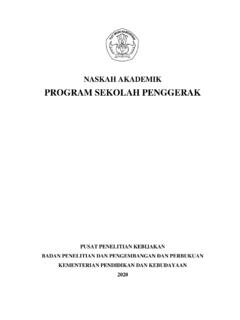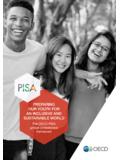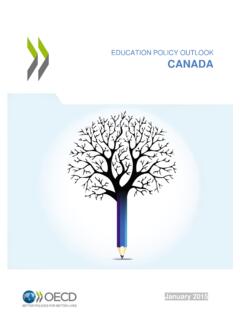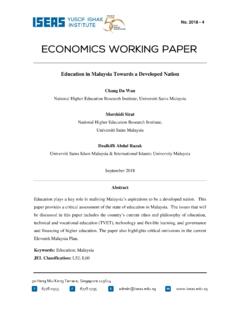Transcription of The reading framework
1 The reading framework Teaching the foundations of literacy January 2022 1 Contents Foreword by Rt Hon Nick Gibb MP, Minister of State for School Standards 3 Introduction 6 Aims 6 Overview 7 COVID-19 recovery 9 Other sources of support 9 Section 1: The importance of reading and a conceptual model 11 Why reading matters 11 The Simple View of reading 15 Section 2: Language comprehension 19 Developing talk 19 Storytimes 28 Poetry and rhymes 36 Section 3: Word reading and spelling 38 Principles underpinning the teaching of phonics 38 Teaching a systematic programme 47 Children with special educational needs and disabilities 55 Developing fluency 57 assessment 61 Section 4: Children at risk of reading failure 66 Keeping up from the start 66 Older pupils who need to catch up 67 Section 5: Leadership and management 72 Headteachers 72 Building a team of expert teachers 74 Section 6: Building on the foundations with older pupils a summary 78 Appendices 80 Appendix 1.
2 For parents: reading stories to children 80 Appendix 2. Supporting children s thinking 82 2 Appendix 3. For teachers: preparing to read a story 84 Appendix 4. An alphabetic code chart 86 Appendix 5. Pronouncing phonemes 89 Appendix 6. Decodable texts for children beginning to learn to read 91 Appendix 7. Guidance for choosing a phonics programme 93 Appendix 8. Audit for leaders and teachers 96 Appendix 9. Glossary 104 Reviewers comments 113 3 Foreword by Rt Hon Nick Gibb MP, Minister of State for School Standards Over the last two decades, there has been a deepening recognition of the fundamental importance of improving reading standards on a child s future academic achievement, wellbeing and success in life. The reading and writing of Standard English, alongside proficient language development, is the key to unlocking the rest of the academic curriculum.
3 Pupils who struggle to read struggle in all subjects a nd the wonders of a knowledge-rich curriculum passes them by unread. Fluency of reading is also a key indicator for future success in further education, higher education and employment. Even more significantly, being a highly engaged reader has the potential to allow a child to overcome their background. In 2000, results from the OECD s programme for international Student assessment (PISA) showed that: while the degree of engagement in reading varies considerably from country to country, 15-year-olds whose parents have the lowest occupational status but who are highly engaged in reading obtain higher average reading scores in PISA than students whose parents have high or medium occupational status but who report to be poorly engaged in reading .
4 This suggests that finding ways to engage students in reading may be one of the most effective ways to leverage social change. 1 This finding remains pertinent, with a 2021 OECD report stating that PISA data consistently shows that engagement in reading is strongly correlated with reading performance and is a mediator of gender or socio-economic status .2 Research by the Institute of Education has also found that the benefits of reading continue as children get older, with the combined effect on children's progress at 16 of regularly reading books and newspapers and visiting the library four times greater than the advantage children gained from having a parent with a degree .3 In short, reading 1 OECD (2002). reading for change.
5 Performance and engagement across countries. Results from PISA 2000 Paris: OECD 2 OECD (2021). 21st-century readers: Developing literacy skills in a digital world Paris: OECD Publishing 3 UCL IoE Centre for Longitudinal Studies (2015). reading for Pleasure Impact Case Study 4 can achieve something teachers and policymakers have been attempting for decades: to lessen or even eliminate the impact of early life disadvantage. Children do not just become readers, however, and reading engagement is not possible if children struggle with the basic mechanics of reading . Fluency and enjoyment are the result of careful teaching and frequent practice. Ensuring children become fluent and engaged readers at the very earliest stages also helps avoid the vicious circle of reading difficulty and demotivation that makes later intervention more challenging.
6 That is why my focus since I became the Shadow Minister for Schools in 2005 has always been on reading . I welcomed the Rose Review in 2006 which recommended that all schools use systematic phonics to teach reading . The evidence for phonics is indisputable, with the EEF considering it the most secure area of pedagogy. In the 15 years since the Rose Review, we have moved on from the reading wars that used to dominate discussion. All schools now use systematic phonics to teach reading and thousands of teachers are ensuring more children are learning to read because of their daily teaching of systematic phonics in schools across England. We introduced two fundamental changes to make this happen: the National Curriculum published in 2013 required schools to teach reading using systematic phonics, and the Phonics Screening Check introduced in 2012 shows how many children are on track.
7 These efforts have begun to pay off. In 2019, 82% of pupils in year 1 met the expected standard in the Phonics Screening Check, compared to just 58% in 2012. For disadvantaged pupils, this figure rose from 45% to 71%. England s scores in international assessments such as the Progress in international reading Literacy Study (PIRLS) have also improved notably, particularly for the boys and the lowest performing pupils. England s progress through championing the teaching of phonics to improve early literacy has attracted attention from across the world, and we have shared our experiences with nations such as Australia, Fiji, Nigeria, Egypt, Lebanon and Jordan. There is more to do, however. The very best schools in our country are achieving near to 100% in the Phonics Screening Check, despite high levels of disadvantage.
8 The effective teaching of reading , as evidenced in these schools, requires not just a systematic synthetic phonics programme but its consistent implementation in every class. These schools also recognise the importance of talk, of accurate assessment , and of building a love of stories and reading . Most importantly, head teachers need to prioritise reading and make it their mission to make sure every child in their school becomes a fluent reader. This reading framework , formed through the contributions of literacy experts and school leaders, many of whom are part of our English Hubs programme , builds on 5 existing progress and shows how schools can introduce these changes with long-term effect. It sets out the core principles of teaching reading for children in Reception and year 1, and for older pupils who have not yet mastered the foundations.
9 It provides support and guidance for school leaders, classroom teachers and Initial Teacher Training partnerships about how to create a school environment where every child is not only able to read proficiently, but also develops a genuine love of reading . I would like to thank all involved in producing and commenting on this document, including reading and language experts, educational organisations, English Hubs Council members, and the 34 English Hubs and partner schools whose expertise has been vital in building an evidence base of what works in teaching early reading . I encourage all primary schools to use this guidance to ensure their children have the strongest possible foundations in reading . Rt Hon Nick Gibb MP Minister of State for School Standards 6 Introduction reading is fundamental to education.
10 Proficiency in reading , writing and spoken language is vital for pupils success. Through these, they develop communication skills for education and for working with others: in school, in training and at work. Pupils who find it difficult to learn to read are likely to struggle across the curriculum, since English is both a subject in its own right and the medium for teaching. This is why the government is committed to continuing to raise standards of literacy for all. Aims This guidance is for primary schools, initial teacher training (ITT) partnerships, specialist provision and others in England. It focuses on the early stages of teaching reading . Its key objective is to help schools meet their expectations around early reading as set out in the national c urriculum and the Early Years Foundation Stage (EYFS) statutory framework .















